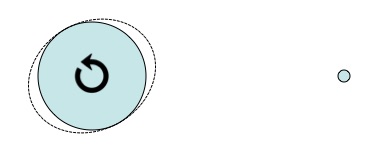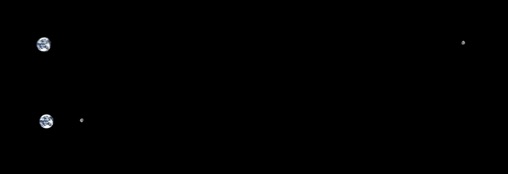The original question was: I know the Moon is getting further away because tides/friction/conservation of angular momentum. This video claims Phobos is getting closer to Mars because of tidal forces, what gives? Obviously no oceans to drag around but what else?
Physicist: A moon causes the material of the planet under it to distend toward it (and away, which is why there are two tides). This is especially obvious on Earth where the water is free to move a lot more than the ground. However that bump takes a little while to relax and, because planets turn and moons orbit, that bump is never exactly under the moon.

The tidal bulge created by a moon doesn’t stay directly under that moon, either because the planet is turning, because the moon is orbiting, or both. This is really, really not to scale.
Because the Earth spins in the same direction that the Moon orbits, our bump leads the Moon a little. If the Moon orbited in the opposite direction, or even orbited so fast that its orbit were faster than the Earth’s spin, then the bump would trail the Moon.
The bump itself has mass and therefore a little extra gravity. If it leads the moon, then the moon speeds up because it’s getting a tiny, tiny extra pull in the direction its orbiting. Speeding up causes things in orbit to assume higher orbits, which we often and not-quite-accurately describe as “drifting away”. Our Moon gets a couple cm farther away every year.
On the other hand, if the tidal bump trails behind a moon, then that moon is slowed down and drops lower as a result. Phobos’ orbital period is about 8 hours (it’s already very low), and Mars’ day (a “sol“) is about as long as ours, so the bump Phobos creates necessarily trails behind it. As a result Phobos is slowly dropping and will eventually impact Mars. Mars is going to have a really bad sol in about 50 million years.
But raising moons consumes a lot of energy and that energy has to come from somewhere. The same tiny pull that the Earth applies to the Moon to speed up its orbit is applied to the Earth to slow down our day. When the Moon formed around 4.5 billion years ago, it about 15 times closer to the Earth (give or take) and a day was only about 6 hours long. Back then a full moon would have provided about 200 times as much light and solar eclipses would have blacked out swaths of the Earth’s surface nearly the size of Australia.
Our Moon has more than 7 million times the mass of Phobos, so Phobos doesn’t have nearly as pronounced an impact on the spin of Mars.
We live in a remarkably unlikely time, when the size of the Moon in the sky perfectly matches the size of the Sun. In fact, since the Moon’s orbit around Earth is a little elliptical, the Moon is sometimes a little smaller and sometimes a little bigger. We live on the only planet that gets to see both annular and total solar eclipses. But see a total eclipse while you can; in a few million years we’ll be stuck with only annular eclipses. Sucks to be you, unforeseeable future generations!








11 Responses to Q: Why is our Moon drifting away while Mars’ moons are falling?